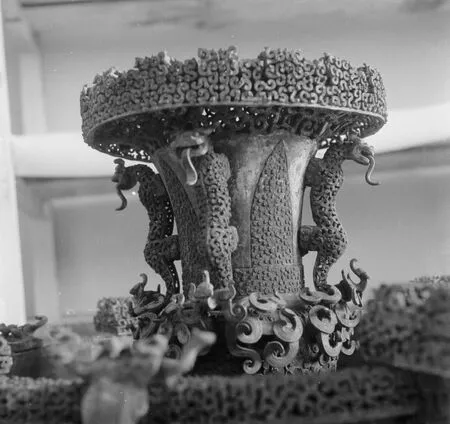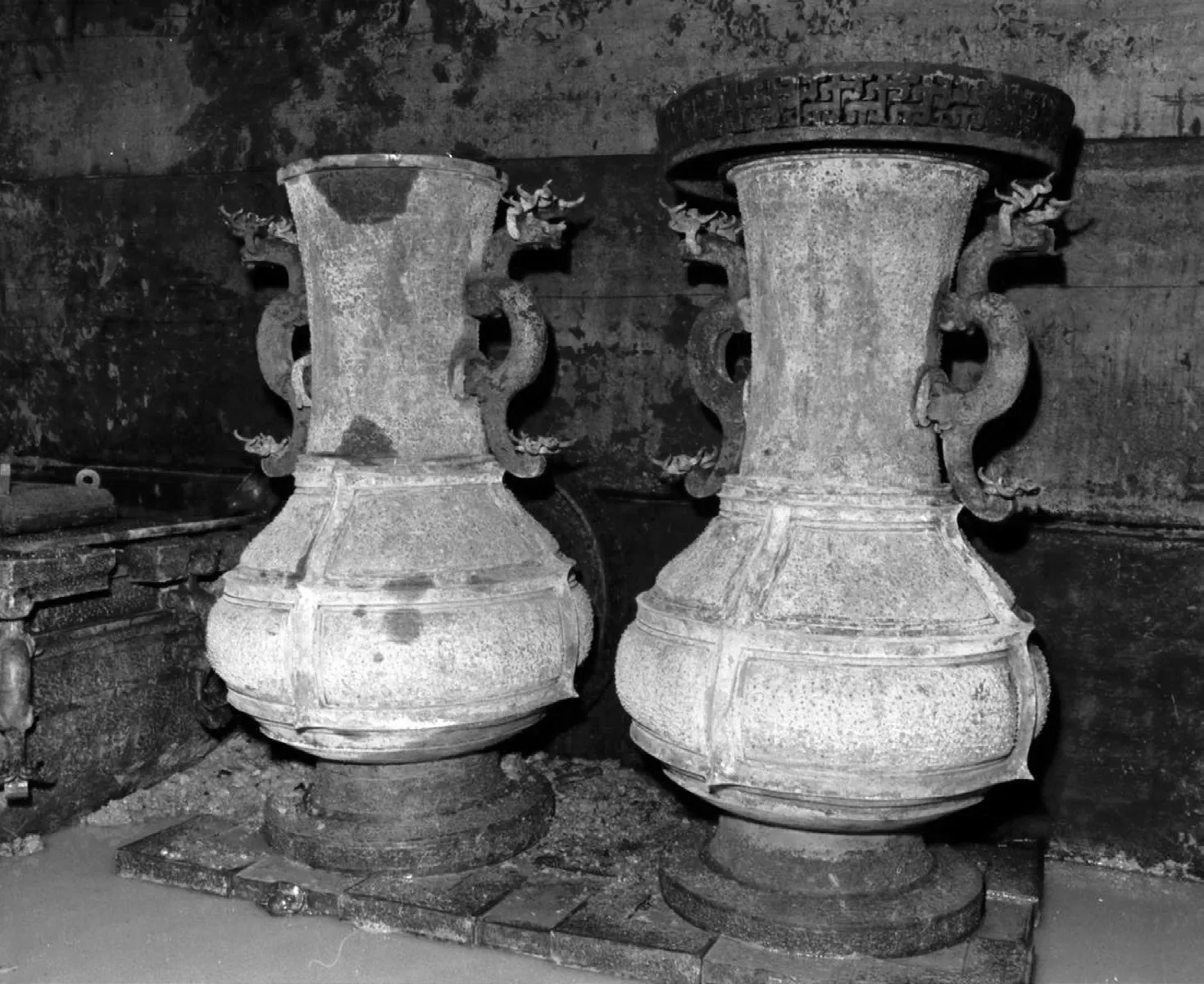Muddy Water & Robber Hole:Mystery to Be Unveiled
2020-09-27TextbyLiuYishan
Text by Liu Yishan
Edited by He Sai & Bai Ning
Photos by Su Zhuolin & Zhang Qijun
The problem was how to remove these cumbersome wood plates now. They might have been very fragile owing to decay.Some suggested lifting them with manpower and some suggested dragging them away with a rope. To cooperate with the excavation,another army unit stationed nearby transferred an eightton crane.
Han Ningfu, the Secretary of the CPC Hubei Provincial Committee and Deputy Director of Hubei Provincial Revolutionary Committee at the time, had a special interest in archeology and the history of Hubei Province. On March 25, 1978, after reading Tan Weisi’s report, he immediately responded, “Please report to the National Cultural Heritage Administration and I agree to organize a strong team to perform the excavation.”
Very soon the report on the excavation of the No.1 Ancient Tomb of Drum-beating Mound received an affirmative reply from the National Cultural Heritage Administration and Hubei Provincial Revolutionary Committee, authorizing the Hubei Provincial Museum to organize the excavation work and Tan Weisi to lead the organization of the excavation team.
On receiving the instruction,Tan Weisi formulated a plan for the excavation with his team members. He started redeploying personnel,transferring technicians from other excavation sites to Suixian County. The National Cultural Heritage Administration dispatched specialists from the Palace Museum headed by fellow researcher Gu Tiefu for on-site guidance. The second year archaeology students at Wuhan University took part in the excavation and Suixian County Revolutionary Committee recruited dozens of local educated youths. A keenwitted and capable team of over one hundred people marched to the Drum-beating Mound.
The Crane Breakdown
On May 11, 1978, the excavation of the Tomb commenced.
The old water tower over the southeast corner of the Tomb pit was dismantled. The remaining fill, paving stone, plaster, and charcoal on the surface of the Tomb foundation were cleared up, and all the demolition work was basically finished on the night of May 14.

A coffin was found at the excavation site. 工人挖掘出棺木
时任湖北省委书记、湖北省革命委员会副主任韩宁夫,对湖北历史与考古情有独钟。1978年3月25日,他看了谭维四的报告后,立即批示:“请告国家文物局,并同意组织强有力的发掘队组织发掘。”
很快,关于发掘随县擂鼓墩一号古墓的报告获得国家文物局和湖北省革命委员会的批复,湖北省博物馆组织实施,谭维四主持组织考古队全力发掘。
接到指令后,谭维四和他的考古队战友们制订了发掘方案。同时,他调兵遣将,从其他发掘现场抽调技术力量聚集随县。国家文物局派出以故宫博物院研究员顾铁符为首的专家到现场指导。武汉大学考古专业1976级参加发掘,随县革委会还从当地招收几十名知识青年参加,队伍一行百余人,兵强马壮,开赴擂鼓墩。
怎么把这些笨重的木头挪开是个问题。这些木头可能已经腐朽易碎,有人建议用人抬,有人建议用绳子拖开。为配合发掘,附近驻扎的其他部队调一辆起重8吨的吊车,供考古队使用。
The next morning, a final clearance was carried out before opening the tomb roof, and all 47 timbers covering the tomb were visible now. The pit assumed a shape of three adjacent squares,divided into northern, eastern,and western chambers. The tomb roof timbers of the eastern chamber were laid out in a northsouth direction, each about 6 meters long, 0.7 meters wide and 0.6 meters thick, totaling 16 pieces; each piece closely connected with another. Those on the northern chamber were relatively smaller, totaling 13 pieces, while those on the western chamber were a bit thinner but bigger and longer,each measuring over 9 meters and the longest nearly 10 meters in length, and also with a very tight seam between the timbers.These timbers were all made of giant trees, each processed with a single piece of catalpa wood measuring between 2 to 3 cubic meters. Their surfaces assumed a blackness, and because of perennial burials, they were soaked totally by water.The small ones weighed more than a ton each, and the bigger ones more than two tons. After uncovering the roof, the tomb pit came in sight below.
The problem now was how to remove these cumbersome wood plates. They may have been very fragile owing to decay. Some suggested lifting them with manpower and some suggested dragging them away with a rope. To cooperate with the excavation, another army unit stationed nearby transferred an eight-ton crane. After the pit area had been cleared, it was no problem to install and operate the crane. However, fearful of the wood being damaged during the lifting process, some of the crew doubted the safety of the relics once using the crane. Tan Weisi and Guo Dewei had to consider the feasibility of the plan again.
Compared with the roof timbers of the No. 1 Tomb at the Tianxing Temple, the cover plates here at the Drum-beating Mound were thicker and better preserved. The cover plates at Tianxing Temple could be pulled out by trucks, so they thought that those at the Drumbeating Mound would be even more durable. Furthermore,in the course of clearing the cover fillers, not a single sign of breakage was found. They ultimately decided the crane was the best option.
On the night of March 16,they started lifting the timbers covering the No. 1 Ancient Tomb of Drum-beating Mound,beginning from the one with a hole left by robbers. As the plank severed by the robbers got stuck on a giant rock, it took them quite some effort to lift it up. The second was a much easier job.However, the crane broke as it was trying to lift the third one.The crowd who desired to see the treasure in the tomb that night left disappointedly. Only the archaeologists remained at the site.
The remaining crew silently looked at the robber hole and the two timbers that had been hung away from the tomb pit.The tomb robbers had used sharp tools such as axes and chisels to chop. It could be inferred from the fractures that the tomb robbers had likely visited the Tomb before the Sui and Tang Dynasties.
The Robber Hole
Viewed from the robber hole and the opening of the two timbers,the pit was full of muddy water and black mud under the dim yellow light.
Would there be anything left in the pit? The robbers had dug such a big hole and entered the outer chamber. What treasures did they steal? Tan Weisi and the group of archaeologists were worried about it.

Part of a bronze zun (wine vessel) 铜尊(局部)
好事多磨
1978年5月11日,随县擂鼓墩一号古墓发掘开始。
拆除清理压在墓坑东南角的旧水塔、清除墓基表面的残存填土、铺石、白膏泥、木炭等工作5月14日夜里基本完成。
15日上午,对木椁盖板作开启前最后一次清理,47块盖板全部显露出来。盖板也称椁盖板。墓坑的形状由三个方形拼合而成,分为北室、东室和西室。东室椁盖板南北铺放,每块约长6米,宽0.7米,厚0.6米,共16块,块与块之间严丝合缝。北室之上的椁盖板略短小,共13块。西室椁盖板虽薄一些,但长且大,每块长9米多,最长的近10米,板与板之间严丝合缝。这些椁盖板都是巨型枋木,都是用整棵的梓木加工而成,每根2至3立方米不等,外表均呈黑色,因常年掩埋,含有大量水分,小的重达1吨多,大的超过2吨。把这些椁盖板揭开,下面就是古墓坑了。
然而,怎么把这些笨重的木头挪开是个问题。这些木头可能已经腐朽易碎,有人建议用人抬,有人建议用绳子拖开。为配合发掘,附近驻扎的其他部队调了一辆起重8吨的吊车,供考古队使用。墓坑四周已清理完毕,吊车进出、安装、运转都不成问题。吊车司机在现场勘测过,不论从哪个角度都可以起吊,吊臂也够长。由于怕起吊的过程中,枋木断裂砸伤文物,大家对吊车吊还是不放心。谭维四和负责清理的小组长郭德维等人不得不从各方面论证吊车起吊可行性。

Bamboo slips unearthed 出土竹简
A sudden thunder stampeded,and a heavy rain poured down.They quickly packed up their tools and clothes and went back to the barracks. It rained all night and most of the next day. Around 3 pm, the sky began to clear up.
Because they did not have time to build a shelter over the grave,the workers could not work.Rainwater flooded into the pit,submerging the roof timbers.
The archaeological team installed a pump and inserted it into the cave to pump out the water.
The heavy rain not only filled the Tomb with water, but also drowned out some of the crew’s enthusiasm, especially those who hoped to discover perhaps an ancient corpse or important cultural relics in the Tomb.If you discovered important cultural relics or ancient corpses,the country would pay for the establishment of museums, and the county could gain instant fame.
However, the heavy rain made Tan Weisi more calm and steadfast. He and Gu Tiefu, the famous archaeologist from the Palace Museum—then in his late seventies—stood by the roof after the rain. Looking at Gu Tiefu’s calm expression, Tan Weisi asked: “Mr. Gu, What is your judgement of this Tomb?”
从盗洞和揭开两块椁盖板的豁口看下去,昏黄的灯光下,满坑是浑浊的水和黑乎乎的淤泥。
里面还有东西么?盗墓贼挖了这么大的洞,进入椁室了,他们盗走了什么宝贝?
与天星观一号墓的椁盖板相比,擂鼓墩墓的盖板粗大,保存良好。天星观的椁盖板能用卡车拉没折断,说明韧性很好,而擂鼓墩的应该更有韧性,因为这种木料越粗大,内部保存越好,安全越有保障。再者,在清理这些盖板填充物的过程中,未发现盖板有半点断裂迹象。大家的意见基本趋于一致:用吊车起吊。
5月16日晚,擂鼓墩一号古墓的椁盖板开始起吊,先从有盗洞的那块椁盖板开始。因为被盗墓贼割断的那根椁盖板被一块大石卡住,颇费了些工夫才吊起来。第二块比较顺利,吊第三块椁盖板时,吊车出了故障。原本以为当晚就可以见到墓内宝贝的现场群众,心里凉了半截,失望地散去,现场只留下考古人员。
大家默默地看着盗洞和已吊出墓坑外的两块椁盖板,觉得好事真多磨。椁盖板截断的原因,是盗墓贼用斧头、凿子之类的锐器劈凿所致,从断裂处推断,盗墓贼应是在隋唐之前光临此墓的。
盗洞疑云
从盗洞和揭开两块椁盖板的豁口看下去,昏黄的灯光下,满坑是浑浊的水和黑乎乎的淤泥。
里面还有东西么?盗墓贼挖了这么大的洞,进入椁室了,他们盗走了什么宝贝?谭维四和一批考古人员都在担心这一问题。
这时,突然一声炸雷响起,大雨倾盆而下。众人赶紧收拾工具和衣物撤回军营住处。
雨下了一夜又大半个白天,直到第二天下午3点,天才开始转晴。
因为墓坑没来得及搭建防雨棚,人们不能工作,雨水积于坑内,淹没了椁盖板。
考古队调来潜水泵,插入盗洞内抽水。
一场大雨,致使墓坑内满是积水,把一些人的热情浇熄了,特别是那些希望古墓内能挖出个古尸和重要文物的人。发现重要文物或古尸,国家就会出钱建博物馆,随县也能名扬四海。
大雨却把谭维四浇得冷静而坚定了。他和年近七旬的著名考古专家顾铁符站在雨后的墓坑椁盖板上。看着顾铁符淡定的神情,谭维四问:“顾老,您看这墓内的情况?”
顾铁符反问:“你看这盗洞是哪个朝代的?古圆近方么!”
旁边有人问:“啥叫古圆近方?”
谭维四对发问的人说:“顾老说的这话,指的是古代盗洞都是圆形的,近代的都是方形的。”
顾铁符满面和善地对大家说:“盗洞上面的情况已看不到了,据谭队长介绍,我感觉这个盗洞应该是汉代或汉代之前的。根据洞口直径不到一米的情形,洞中仅容一人通过,应是私盗而不是官盗。这么大的墓,里面肯定有大东西,盗墓贼进来,也只能拿走一些小东西,大东西他们拿不出去。我认为大东西没有损失。”
谭维四也是这样认为的,盗洞规模小,洞内又没有发现晚于西汉的遗物,而且像江陵望山一号墓、二号墓,信阳长台关二号墓,长沙马王堆二号墓都有被盗痕迹,但仍出土大量文物。
顾铁符的话像一剂强心针,鼓舞了在场的人,大家对发掘的前景充满了信心。
顾老的分析,谭维四觉得很有道理,心中的信念更坚定了:这墓里一定有好东西。
起重吊车修好了,继续从盗洞开始,向北边一块块地起吊椁盖板。
When all the fortyseven cover timbers were lifted, the structure of the entire tomb was clear. The western chamber was separated by a wall panel and divided into a middle chamber and a side chamber. This tomb had three rooms and one hall—very similar to a modern apartment structure.
Gu Tiefu asked back, “What dynasty do you think this hole belongs to? Don’t forget the saying ‘ancient round and neoteric square.’”
“What on earth does ‘ancient round and neoteric square’mean?” someone inquired.
Tan Weisi answered, “What Gu just said refers to the fact that the ancient robber holes are round,and modern ones are square.”
Gu Tiefu said to everyone encouragingly: “Based on the introduction by Team Leader Tan, I feel that the robber hole is from or before Han Dynasty.Since the diameter of the hole is less than one meter, only one person could pass through the hole, which means this was a small robbery. There must be big things in such a big tomb. Tomb robbers could only take away small things when they came in.They couldn’t have taken out big ones, so I don’t think the big treasures are lost.”
Tan Weisi agreed with him:the scale of the robber hole was small, and no relics later than the Western Han Dynasty had been found in it. Moreover, there were traces of theft in the No. 1 Tomb,the No. 2 Tomb at Wangshan,the No. 2 Tomb at Changtaiguan in Xinyang, and the No. 2 Tomb at Mawangdui in Changsha, but a large number of cultural relics were still unearthed.
Gu Tiefu’s words, full of confidence in the prospect of the excavation, inspired everyone present. Tan Weisi deemed Mr.Gu’s analysis highly reasonable,which further strengthened his belief: there must be wonderful stuff in this Tomb.
After the crane was repaired,they continued to lift the cover planks to the north from the robber hole. When all the planks of the northern chamber had been lifted, the interior was filled with black water. Nothing could be seen except a few small pieces of bamboo sheets floating on the water.
Tan Weisi asked someoneto find a long iron wire and stretched it slowly down the tomb wall. The water depth in the outer chamber was 3.13 meters—almost the height of two adults.
When all the forty-seven cover timbers were lifted, the structure of the entire tomb was clear. The western chamber was separated by a wall panel and divided into a middle chamber and a side chamber. This tomb had three rooms and one hall—very similar to a modern apartment structure.
The four chambers were eventually opened, two painted coffins appeared on the water surface of the western chamber,and eight coffins appeared on the water surface of the eastern,also color-painted. Doubtlessly,these ten coffins were the accompanying coffins, and such a great number fully exhibited the distinguished identity of the host of the Tomb. Worryingly,the whole tomb was full of muddy water. The extent of the ancient theft was still unclear due to the flooding. Tan Weisi frowned slightly, demanding to speed up the drainage. The only thing they could do now was to wait for the emergence of fact as the watersubsided.

Bronze pots on a single stand 联禁铜壶
北室椁盖板全部起吊完了,室内满是积水,除水面漂浮起几小块竹片,什么也看不到。
谭维四叫人找来一根长铁丝顺着椁墙缓缓伸下去,测得椁室内的水深达3.13米,差不多两人深了。
当47块椁盖板全部起吊完毕后,整个墓室的结构清楚了,除北室和东室外,西室中间又被椁墙板隔开,分成中室和西室。这个墓为三室一厅,很像如今的单元房结构。
现场出现了喜忧参半的情绪。
喜的是,四个墓室打开,西室水面浮出两口彩绘棺材,东室水面浮出八口棺材,也是彩绘的,有的盖身已经分离。这十口棺材是陪葬棺无疑,有这么多的陪葬棺,说明这座古墓的主人身份地位不低。忧的是,整个墓坑全是浑浊的积水,晚风吹过,漾起阵阵涟漪。墓坑内的文物到底被盗到什么程度,还是个未知数。谭维四轻轻皱了皱眉头,要求加速排水,只等水落石出。
